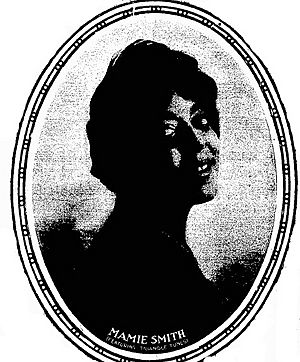Mamie Smith facts for kids
Quick facts for kids
Mamie Smith
|
|
|---|---|

Gravure of Smith in the New York Clipper, 1921
|
|
| Background information | |
| Birth name | Mamie Robinson |
| Born | May 26, 1891 Cincinnati, Ohio, U.S. |
| Died | September 16, 1946 (aged 55) Staten Island, New York, U.S. |
| Genres | Blues |
| Occupation(s) | Actress, dancer, singer |
| Instruments | Vocals, piano |
Mamie Smith (born Mamie Robinson; May 26, 1891 – September 16, 1946) was an American singer, dancer, pianist, and actress. She was famous for her performances in vaudeville, jazz, and blues music. In 1920, Mamie Smith made history. She became the first African American artist to record vocal blues songs. This was a very important moment in music history.
Contents
Early Life and Beginnings
Mamie Robinson was born in Cincinnati, Ohio, in 1891. When she was about 10 years old, she started touring with a dance group. This group was called the Four Dancing Mitchells.
As a teenager, she danced in a show called Smart Set. In 1913, she moved to Harlem in New York City. There, she began singing in clubs. She also married William "Smitty" Smith, who was also a singer.
Breaking Barriers in Music
On February 14, 1920, Mamie Smith recorded two songs. These were "That Thing Called Love" and "You Can't Keep a Good Man Down." She recorded them for the Okeh music label in New York City. An African American songwriter named Perry Bradford helped make this happen. He convinced Fred Hager to record a black singer for the first time.
At first, the musicians playing with Mamie were all white. The record company received threats. Some groups said they would stop buying records if a black singer was recorded. But the record was a huge success! It sold very well and opened the door for many more black musicians to record music.
The Success of "Crazy Blues"
Mamie Smith's biggest hit came later, on August 10, 1920. She recorded more songs written by Perry Bradford. One of these was the famous "Crazy Blues." This song was also for Okeh Records. It sold over a million copies in less than a year!
Many African Americans bought these records. This led to a big increase in sales of "race records." These were records made by black artists, mostly for black audiences. Because of its importance, "Crazy Blues" was added to the Grammy Hall of Fame in 1994. It was also chosen for the National Recording Registry in 2005. This registry keeps important recordings safe in the Library of Congress.
The Rise of Classic Female Blues
Other African Americans had recorded music before Mamie Smith. But they usually performed music that was already popular with white audiences. The huge success of Mamie Smith's record changed everything. It made record companies want to record other female blues singers. This started a new era of music, now known as classic female blues.
Mamie Smith continued to make popular recordings for Okeh throughout the 1920s. She also toured the United States and Europe. She performed with her band, Mamie Smith & Her Jazz Hounds. Their show was called Mamie Smith's Struttin' Along Review.
She was known as "The Queen of the Blues." Later, Bessie Smith became "The Empress of the Blues." Mamie also found that radio helped her reach new fans. She performed on radio stations, especially in cities with mostly white audiences.
Mamie Smith worked with many talented musicians in her band, the Jazz Hounds. Some famous names included Coleman Hawkins, Johnny Dunn, and Bubber Miley.
Film Career and Later Years
Mamie Smith also appeared in movies. She was in an early sound film called Jailhouse Blues in 1929. She stopped recording and performing music in 1931. However, she returned to acting in 1939. She appeared in the movie Paradise in Harlem. Her husband, Jack Goldberg, produced this film.
She also acted in other movies. These included Mystery in Swing (1940), Sunday Sinners (1940), Stolen Paradise (1941), Murder on Lenox Avenue (1941), and Because I Love You (1943).
Death and Memorial
Mamie Smith passed away in 1946 in New York. She was buried at Frederick Douglass Memorial Park on Staten Island. For many years, her grave did not have a headstone.
In 2012, a campaign began to get a headstone for Mamie Smith. Michael and Anne Fanciullo Cala, a blues journalist and editor, started a crowdfunding effort. They raised over $8,000 to buy a four-foot-high granite headstone. It featured an image of the blues singer.
The monument was finally placed at Frederick Douglass Cemetery on September 20, 2013. This was 67 years after her death. Any extra money raised was given to the cemetery for its care.
Hit Records
| Year | Single | US Chart |
|---|---|---|
| 1920 | "Crazy Blues" | 3 |
| 1921 | "Fare Thee Honey Blues" | 9 |
| "Royal Garden Blues" | 13 | |
| "You Can't Keep a Good Man Down" | 4 | |
| "Dangerous Blues" | 6 | |
| 1922 | "Lonesome Mama Blues" | 6 |
| 1923 | "You Can Have Him, I Don't Want Him Blues" | 13 |
| "You've Got to See Mama Ev'ry Night (Or You Can't See Mama At All)" | 13 |
See also
 In Spanish: Mamie Smith para niños
In Spanish: Mamie Smith para niños

